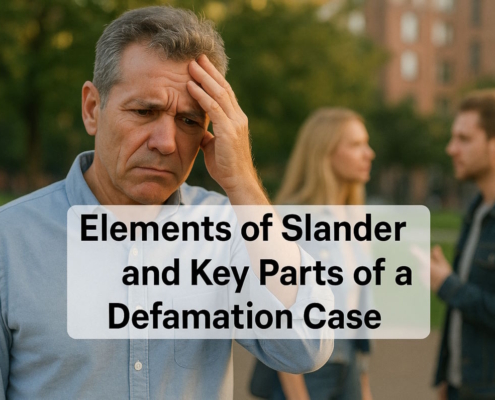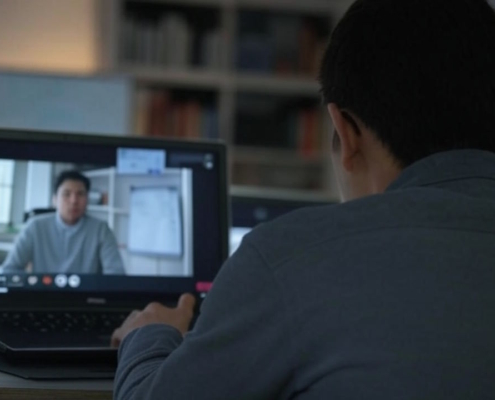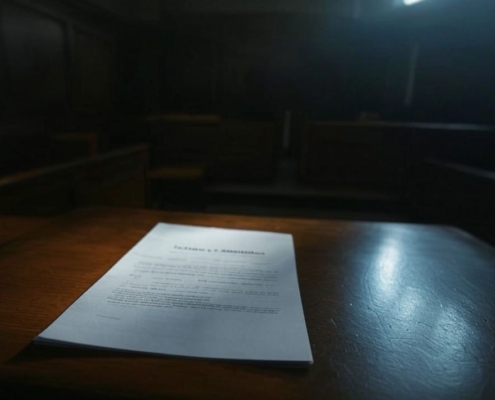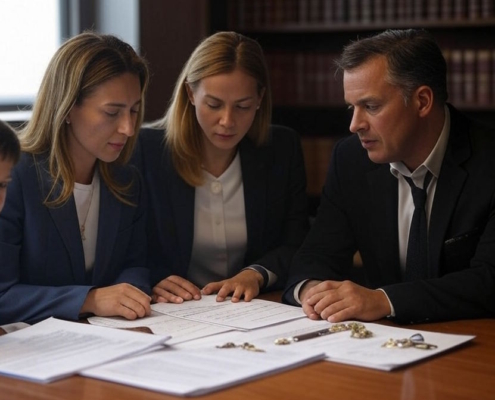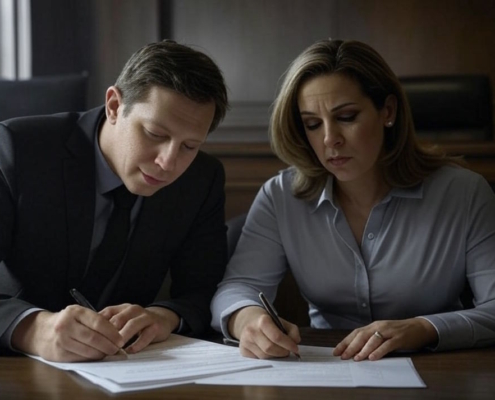What is the meaning of ex parte in a legal sense?
The phrase “ex parte” is crucial in the complex realm of court procedures. A term with its roots in Latin — “from one side” — it describes a situation in which one party takes legal action without the other party being present. While this idea is vital in cases requiring swift judicial involvement, it does bring up questions regarding the openness and equity of the justice system.
From emergency custody hearings to interim restraining orders, ex parte actions are common. Their ability to expedite the judicial process is commendable, but maintaining justice requires a careful equilibrium.
Anyone working in the legal field or with the court system must be well-versed in the intricacies of ex parte proceedings because of the profound effect they have on case strategy and final verdicts. Delving into the complexities of ex parte, the following article explores the relevance and consequences of this legal concept in the present day.
Definition and application of “ex parte”
In Latin, “ex parte” means “from one side.” This phrase can be used to describe any time a judge talks to only one side (or one side’s lawyer) in a court case.
In extraordinary circumstances, the court may order an ex parte hearing, which runs counter to the constitutionally protected right to due process. Although the term is most often used to describe a scenario involving an emergency, it can also describe excessive interaction between a judge and one side in the absence of proper protocol.
Some scenarios that may call for an ex parte hearing are as follows:
An individual seeking urgent protection from an aggressor in a domestic violence situation may obtain a temporary restraining order.
When a parent believes that their child’s safety is in imminent danger, they may seek temporary exclusive custody of the child.
The purpose of a temporary restraining order is to provide the victim with protection from the aggressor while the proper notification process takes place, in the event of harassment or stalking.
For example, in a divorce dispute, one party may ask the court to place a temporary freeze on the assets of the other party because they are afraid that the other may steal or hide them.
To avoid infringing on the rights of the omitted party, courts impose strict rules on the application of ex parte hearings. The party seeking the hearing must demonstrate the extreme necessity of the matter and the reasons why the other party’s notification would likely result in immediate injury.
For example, emergency custody proceedings depend on ex parte circumstances to safeguard youngsters from immediate danger, and legal professionals see ex parte petitions as crucial instruments for maintaining rights when postponement may result in injustice.
Although ex parte procedures are necessary, they do create worries about one-sided decision-making. To address these issues, the courts adhere to strict rules that ensure the interests of the absent party are taken into account. Openness is prioritized to ensure fair judicial processes.
Ex parte proceedings are effective, but they are not without their obligations. Lawyers must present thorough proof to support the omission of the other side during vital processes.
Background and Development
The first examples of ex parte procedures can be found in Roman law, where one party could be unilaterally granted a court order to resolve an urgent matter. These practices later became part of the common law, developed in England’s legal systems and eventually found their way into American jurisprudence.
Originally, ex parte proceedings were employed when swift action was required but bureaucratic fairness needed to be fine-tuned. In the seventeenth century, the English courts had set specific rules for ex parte processes, stressing the need to present clear proof to justify one-sided proceedings. These rules laid the groundwork for modern ex parte processes and shaped their place in current legal frameworks.
Important Case Law
The limitations and practice of ex parte proceedings have been defined by a number of significant cases. One of these, United States v. Gonzales-Lopez (2006), emphasized the need to balance the defendant’s rights with the necessity for quick court intervention.
Another notable case, Fuentes v. Shevin (1972), was where the U.S. Supreme Court looked at ex parte before pre-judgment replevin orders, underlining the necessity of due process even in pressing actions. These and other precedents have established legal standards that guarantee the reasonable use of ex parte actions, supporting fairness and safeguarding individual rights while enabling quick judicial action when needed.
Different Forms of Ex Parte Cases
In many areas of law, ex parte procedures play an important role, especially in cases of great urgency, as they let the court to step in quickly while still being true to the letter of the law.
1. Ex Parte in Cases of Civil Law
In civil cases, ex parte actions frequently occur when quick court orders are needed. For example, in TROs, one party seeks protection from imminent harm or harassment with no delay; the court issues the TRO without contacting the other party to avoid any harm. Another example is emergency child custody orders, in which one parent senses a danger to the child’s immediate safety; to defend this action, the applicant must show a strong case of urgency, and subsequent hearings will address the rights of the absent party.
2. Ex Parte in Criminal Cases
The following are some examples of ex parte actions in criminal cases: arrest or search warrants, protective orders for domestic violence victims, where the immediate safety of the victim is prioritized, and the state’s interests in catching suspects balanced with the due process rights of the accused, guaranteeing just proceedings; and ex parte requests from law enforcement officers presenting probable cause are often the basis for such warrants.
The Pros and Cons of Ex Parte
Justice requires a delicate balancing act between swift court action and impartiality, which ex parte procedures give while also posing obstacles.
Reasons to Use Ex Parte Actions
- Quick Remedy: In cases where time is of the essence, the courts can make orders through ex parte procedures. A temporary restraining order, for instance, might prevent impending harm.
- Protection of Rights: These proceedings ensure that the rights of the parties involved are safeguarded by moving quickly, preventing any potential compromise that may result from lengthy legal processes.
- Emergency Protection: Ex parte measures allow for quick involvement in dangerous situations, including protecting kids, without having to wait for a complete hearing.
Drawbacks of Using Ex Parte Actions
- Lack of Input from the Opposing Party: In ex parte acts, the missing party often doesn’t have a say, which means that choices may be made based only on one side of the information.
- Potential for Abuse: The presenting party might inflate their situation in order to get what they want, which could lead to abuse.
- Issues with Openness: When one side is not present during decision-making, it calls into question the impartiality and openness of the process, which puts the integrity of the justice system at risk.
Famous “Ex Parte” Decisions
Famous ex parte decisions have been essential in establishing the rules of law that courts must follow. These cases show how extensive and complicated ex parte applications may be in many areas of law.
Lambdin P. Milligan appealed his military conviction in Ex Parte Milligan (1866), and the Supreme Court held that military courts could not constitutionally try civilians when civil courts were open. This decision reinforced the significance of civilian legal processes and regulated military power in civil matters.
In the landmark case of Ex Parte Merryman (1861), Chief Justice Roger Taney, in his capacity as a circuit judge, supplied a writ of habeas corpus to release John Merryman from military custody. The case concerned the suspension of habeas corpus by President Lincoln during the Civil War, which was challenged on the grounds that only Congress could withhold this right. The case served to emphasize the delicate balance of power between the executive and the judiciary in times of extraordinary demands.
In the landmark decision Ex Parte Quirin (1942), the Supreme Court supported the use of military commissions to put enemy combatants on trial, including German saboteurs captured on U.S. soil during WWII. This decision had far-reaching implications for the authority of military tribunals and the due process rights of individuals designated as enemy combatants.
Effects on the Judiciary
In defining the extent of judicial power and procedural limits, particularly as they pertain to civilian and military authority, ex parte decisions have a lasting impact on the legal system. For example, Ex Parte Quirin reinforced military judicial authority in situations involving national security threats, while Ex Parte Milligan emphasized the supremacy of civil courts over military tribunals in protecting personal rights during times of peace.
Legal scholars continue to look to these landmark ex parte rulings for guidance as they navigate the complexities of urgent legal measures within a structured legal framework. Courts frequently reference these rulings when settling emergency actions, guaranteeing a balance between executive actions and legal oversight.
What steps are involved in filing an ex parte application?
While each state has its own specific process for ex parte applications, this is generally how it plays out.
In certain states, you are required to file an ex parte application or motion with the judge, which includes your affidavit and any exhibits you wish to attach. The goal of this application is to persuade the judge that you, the petitioner, require an immediate order due to an urgent situation.
A judge may decide to issue an ex parte order based on the paperwork alone in some states; in others, they may want you to appear and answer questions to establish the seriousness of your case. This process is known as judicial review.
Presenting your ex parte application before the judge is a common practice in many jurisdictions. After filing it with the clerk, you will be asked to wait in the courthouse until the judge reviews the documents or requests a conference with you.
You may be required to provide notice to the opposing party at least one day prior to the emergency hearing in certain states, like California. However, in California, notice is not necessary if you can establish that there is a substantial danger of physical harm resulting from the denial of the ex parte order.
The intricacy of ex parte requests, together with the fact that state procedures differ, makes it imperative that you seek the advice of a local attorney who is well-versed in your particular legal matter and the laws of your jurisdiction.
When a judge has finished reviewing an ex parte motion, what comes next?
The next step, supposing the court grants the motion, is to schedule the ex parte court session.
Judges have the discretion to grant ex parte motions and issue temporary orders, such as full custody orders or restraining orders, in cases where the other party was not present. These orders, although brief, are still legally binding and enforceable, and there are serious consequences for violating them.
These are some things that ex parte orders can do:
- Stop the other person from leaving the country or state with a child.
- Stop the opposite side from causing property damage.
- In a divorce case, stop the opposing side from taking your assets.
- Demand that the other party refrain from harassing you and keep away from you.
A hearing must be held by the court with the participation of all parties involved before an order can be made permanent. The duration of the hearing can vary from state to state, with some requiring a full hearing within 10 days and others between 14 and 20 days. The purpose of the hearing is to ensure that the other party has been afforded their due process rights.
Even if the court rejects your ex parte motion, you and the respondent are both required to present at the hearing that may be scheduled soon thereafter.
What takes place at the full hearing?
While the specifics may differ from one court or state to another, the broad outline of a complete hearing is as follows: both you and the respondent will present evidence through witness statements and any supporting documents you may have, including photographs, medical records, and police reports.
If you do not show up for the hearing, the judge will throw out the order. If the respondent does not show up, it’s likely that you will get a permanent order that lasts for about a year. In some states, the judge can automatically grant a permanent order if the respondent doesn’t show up.
The ex parte order will become a permanent order without testimony if the respondent shows up and doesn’t dispute it. If the respondent shows up and objects to the order, then a trial will be held where both of you will testify and present evidence. The judge will then decide if a permanent order is necessary or if the petition should be dismissed.
Misunderstandings Regarding Ex Parte
It is commonly believed that removing the opposing party in an ex parte procedure automatically benefits the petitioner. However, this method is only allowed in very limited situations necessitating rapid action, such as in cases for immediate protection orders or restraining orders, in order to avoid injury.
The lack of finality of decisions reached in ex parte proceedings is a common misunderstanding; in fact, such rulings are typically temporary and are subject to full hearings in which all parties are present to maintain judicial equity and balance.
Despite the fact that ex parte acts are seen as arbitrary because the other party is not present, the courts nonetheless demand extensive evidence to support one-sided decisions, and they are constrained by checks and balances to prevent their abuse.
Ex parte proceedings are not just common in civil cases, but they are also an important part of criminal procedures, particularly when getting warrants or temporary protection orders that need judicial supervision for due process.
FAQs
1. Does someone have to pay to submit an ex parte application?
The filing fees for ex parte applications differ by jurisdiction but typically consist of a conventional court filing charge (which can be anywhere from $50 to $400). In certain situations, fee exemptions are offered for those who are unable to pay the filing fees.
2. In an ex parte hearing, is legal representation necessary?
Ex parte hearings, like any legal proceeding, may be complicated, therefore it’s best to work with a lawyer who can explain your case to the judge properly. However, you are not obligated to have a lawyer.
3. Will an ex parte order last forever?
In most cases, an ex parte order is only in place for a short period of time, usually between ten and twenty days, depending on the jurisdiction, until a full hearing can be scheduled with the participation of both parties.
4. Could the other side challenge an ex parte order?
The opposing party (or its attorney) has the right to request a hearing following notice of the order in order to contest the judge’s decision. Following the presentation of evidence and arguments, the judge will decide whether to keep, change, or dissolve the temporary order.
5. What does ‘proceed ex parte’ mean?
Proceeding ex parte means to go ahead with legal action without the other party being there or having a say in it. In court, this usually happens in an emergency where one party needs help right away. However, one-sided legal proceedings are against the rules of legal ethics and civil procedure, so there are strict guidelines that must be followed in ex parte cases to avoid misconduct.



